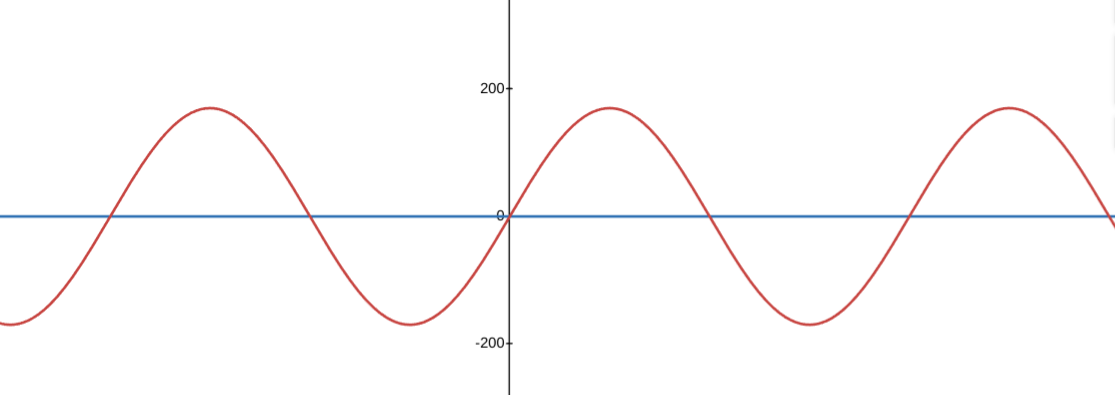你一个外国的不要对美国电线怎么接发表意见。
美国断路器像开关一样,只有一火进一火出,不给你机会检测零线电流。
版主: Softfist
你一个外国的不要对美国电线怎么接发表意见。
verdelite 写了: 2025年 4月 12日 03:36 你一个外国的,不要对美国电路怎么接发表意见。
美国火线和地线之间的漏电断路器也不是必然有的。是按安装在插座上的,一个回路一个。新房子可能都装了,但是老房子、没装的,需要自己装。
而且火线和零线之间那叫用电器,不可能装“漏电监测器”。
配电箱上面那个是总开关吧?上面可能标着150 200 这样的大电流应该就是了。
蓝线是零线,就是中间抽头,因为在变压器处接地,它的电位是0。 红线是一个火线,它的绝对电位就是这样绕着0线上下翻飞,最高峰值是170V,最低谷是-170。 从交流电(比如这俩线通过一个大电容之后, 或者这俩绕在一个变压器的初级上)的观点看, 这俩线之间的最高电压是170V,RMS电压是170/1。414 =120V。

这个图里加上了另外一根火线(紫色)的电压,实际就是红色的电压乘以一个负号。

这个看起来很奇妙,怎么一个变压器,一头接地,另一头就会围着他翻到负值呢。huangchong 写了: 2025年 4月 12日 11:27 蓝线是零线,就是中间抽头,因为在变压器处接地,它的电位是0。 红线是一个火线,它的绝对电位就是这样绕着0线上下翻飞,最高峰值是170V,最低谷是-170。 从交流电(比如这俩线通过一个大电容之后, 或者这俩绕在一个变压器的初级上)的观点看, 这俩线之间的最高电压是170V,RMS电压是170/1。414 =120V。

对啊,上面那个正方形的东西里面就有总闸。Monday太糊涂了,居然这都没看见。huangchong 写了: 2025年 4月 12日 11:03 配电箱上面那个是总开关吧?上面可能标着150 200 这样的大电流应该就是了。
(图放大了看,确实写着200,那就是200A的总容量,控制两条120V RMS的火线,总容量是48kVA。 而且旁边还印了大黑字 main)
huangchong 写了: 2025年 4月 12日 11:03 配电箱上面那个是总开关吧?上面可能标着150 200 这样的大电流应该就是了。
(图放大了看,确实写着200,那就是200A的总容量,控制两条120V RMS的火线,总容量是48kVA。 而且旁边还印了大黑字 main)
 x1
x1

小菊花上次还教叔英语。不服不行。geust 写了: 2025年 4月 12日 11:58 北美的人问题是北美的地线零线绑定规范,小菊花套用日本的规范。
In Japan, electrical systems differ from those in North America, particularly regarding grounding and bonding. Japanese homes typically use a distribution board (分電盤, bundenban) instead of a main breaker panel. However, the grounding system is often separate from the neutral, unlike in the U.S., where bonding occurs at the main panel.
Japanese electrical systems generally follow TT grounding, meaning the ground and neutral are not bonded at the panel but instead grounded separately. This differs from the TN-C-S system commonly used in North America, where neutral and ground are bonded at the main panel.

果然不一样,看来小举也没错啊,只不过驴唇不对马嘴而已。geust 写了: 2025年 4月 12日 11:58 北美的人问题是北美的地线零线绑定规范,小菊花套用日本的规范。
In Japan, electrical systems differ from those in North America, particularly regarding grounding and bonding. Japanese homes typically use a distribution board (分電盤, bundenban) instead of a main breaker panel. However, the grounding system is often separate from the neutral, unlike in the U.S., where bonding occurs at the main panel.
Japanese electrical systems generally follow TT grounding, meaning the ground and neutral are not bonded at the panel but instead grounded separately. This differs from the TN-C-S system commonly used in North America, where neutral and ground are bonded at the main panel.